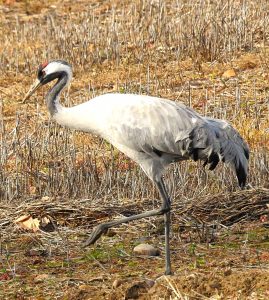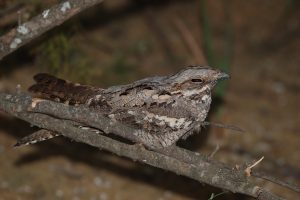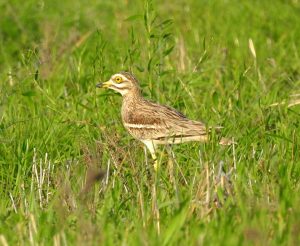There are also many steppe birds in Extremadura, that inhabit the great plains, grasslands, cultivation areas… here are the most outstanding ones.
Black-bellied sandgrouse Pterocles orientalis

Like its companion, it is also in decline. It differs from the Pin tailed Sandgrouse in having less striking colors, being slightly larger, having shorter tail feathers and a black belly. They are also easily differentiated by their song. It is generally more abundant and can be found in more areas than the Pin tailed Sandgrouse. We can observe it in the vicinity of Badajoz, Los Llanos de Cáceres, La Albuera and the southern Campiña, among other places.
Calandra lark Melanocorypha calandra

It is the largest of the Extremaduran allaudids, a little larger than a crested lark. It is characterized by black spots on both sides of its neck and feeds on insects, worms and seeds. The calandra lark has a predilection for dry crops, pasture, fallow land and treeless fields. It is distributed throughout the region and is not threatened, although modern agricultural practices are negatively influencing its populations.
Common crane Grus grus

One of the largest steppe birds in Extremadura, in winter tens of thousands of specimens visit the community (it is their main wintering ground), filling the pastures, lagoons and rice fields with life. It feeds on acorns, seeds, invertebrates… and it is very common to see it in its daily movements from its roosts to its feeding areas. We can see it all over the community, in the above mentioned ecosystems.
Common quail Coturnix coturnix

It is the smallest of the peninsula’s galliforms, slightly larger than a blackbird. It is migratory and visits us in spring and summer to breed, although there is an increasing percentage of sedentary individuals. The common quail feeds mainly on seeds and insects and is distributed throughout the region. Its populations have been greatly reduced in recent decades due to changes in agricultural practices and hunting. It frequently grows in irrigated crops, although it can also be found in grasslands or dry crops as long as there is water nearby.
Corn bunting Emberiza calandra

A little bigger than a sparrow, it’s another typical steppe bird. A bird with a robust beak, it specialises in eating seeds, although during breeding it also eats small insects. It is very common to see its silhouette on top of poles or dry trees singing. Very abundant in crop areas, pastures, open grasslands… it is also present throughout the region. It is often seen perched on wire fences and roadside posts and if approached with care is relatively easy to photograph. It is quite a trusting bird.
Crested lark Galerida cristata

It is one of the most typical and characteristic inhabitants of the open areas of the region. Very common in cultivated areas, fallow lands, moors and other plains with little vegetation cover. It is very typical to see it along rural roads in search of small seeds or invertebrates. It is one of the most abundant birds in these ecosystems, although it has also been negatively affected by changes in agricultural practices.
Eurasian skylark Alauda arvensis

Similar in size to a sparrow, it is one of the most typical birds of the open fields of Extremadura. It has a small chignon which it may or may not display depending on its mood. The eurasian skylark feeds mainly on seeds, plant remains and insects. It is very common in any treeless area: crops, pastures, moors… even in low bush areas. Its population is abundant throughout the region and usually is gathered in numerous flocks
European nightjar Caprimulgus europaeus

This strange animal, the size of a turtledove, has wings and a tail so long that it looks much bigger. It is found in Extremadura during the breeding season. It feeds on insects from dusk until dawn, during the day it remains motionless on the ground and its truly mimetic plumage makes it a very difficult bird to observe. The best way to spot it is to look for it on the dirt roads during the twilight. The northern end of Cáceres together with Monfragüe and Villuercas are the best points to observe it.
European roller Coracias garrulus

The european roller is a very unknown bird, which lives in the great plains of Extremadura with little or no trees. The size of a jackdaw, and insectivorous food, it visits us in spring and summer to reproduce. It is unmistakable thanks to its bright green and blue colours, and its population is becoming increasingly scarce. The area of Los Llanos de Cáceres, Magasca and Trujillo is a very good place to see it, as they take advantage of the nest boxes installed on the nearby power poles.
European stonechat Saxícola rubicola

A small bird slightly smaller than a sparrow, it is typical of open pastures, boundaries and farmland. It is very common to see it on paths, climbing over walls, wire fences or power lines. Present throughout the year in the whole region, it feeds on small insects that it locates from its stands. Nowadays it is quite frequent and its population is not threatened.
Great bustard Otis tarda

The Great Bustard is the largest bird in the Iberian Peninsula, and we also find its main populations in Extremadura. It inhabits large treeless plains and extensive crops, both dry and irrigated. It is very suspicious and the best way to observe it is from a vehicle. Its main population centres are in La Albuera, Los Llanos de Cáceres, La Serena and the meadows west of Arroyo Conejos reservoir, in Llerena. Also you can see it very close to Badajoz, if you want to see them, just contact me.
Greater short-toed lark Calandrella brachydactyla

Inhabitant of cultivated and steppe areas, it can be seen in Extremadura except in the coldest months, when it migrates to Africa to hibernate. Frequent in cultivated areas and large grasslands, it feeds mainly on seeds, although in spring it also feeds on invertebrates. Rather small in size, it is characterised by its ochre tones on its back and much whiter chest and ventral area, with no striations. It does not normally like high altitudes and can be seen all over the region.
Little bustard Tetrax tetrax

Classified as endangered in Extremadura since 2016, its population decline in the last 2 decades has been impressive. It’s one of the steppe birds more endangered in the entire country. Modern agricultural practices are very detrimental to it and sightings are increasingly rare. Its main habitat is the cereal plains and treeless steppes, and the highest concentrations are found in La Campiña Sur, La Serena, La Albuera, the area of Orellana and Los Llanos de Cáceres.
Peewit Vanellus vanellus

Another of the most common steppe birds in the region, although it could also be included within the aquatic ones due to its predilection for wetlands. It comes in large flocks during the winter season flooding meadows, pastures and grasslands with low grass. It feeds on worms and small invertebrates. Some pairs stay all year round and breed in the community. We can observe it all over the region, although La Campiña Sur, La Serena, the ZEPA of Alange, La Albuera, surroundings of Orellana and Sierra Brava, Llanos de Cáceres, Magasca and Trujillo are the best areas.
Pin-tailed sandgrouse Pterocles alchata

This beautiful bird, the size of a dove, is typical of semi-arid areas, steppes and dry crops and its food is almost exclusively granivorous. As it nests in the soil, modification of agricultural practices is one of its main threats and its populations are in clear recession. Less frequent than its relative the Black bellied sandgrouse, it is one of the rarest steppe birds in Extremadura. The best areas to observe it are Los Llanos de Cáceres and Trujillo, Llanos de Brozas, Moheda Alta, Campiña Sur and La Serena.
Red-necked nightjar Caprimulgus ruficollis

Much more common than its relative, it differs mainly by its redder shades and its slightly larger size. It is distributed practically throughout the community and has very similar habits, frequenting open fields with scattered bush vegetation. We can also observe it on the edges of the woods. Like the European, the best way to see it is to look for it on the roads at dusk or dawn.
Stone-curlew Burhinus oedicnemus

One of the most curious steppe birds in Extremadura, with a twilight and nocturnal habit, feeds mainly on small invertebrates in plains, grasslands and dry farming areas. During the winter months they group together in roosts and due to their habits the best times to observe them are dawn and dusk. Los Llanos de Cáceres y Trujillo, Vegas Altas del Guadiana, Campiña Sur, La Serena and La Albuera, as well as the environments of Orellana and Sierra Brava are the best areas to observe them, along with other steppe birds.
Tawny pipit Anthus campestris

This pipit is quite common in the northern half of the Iberian Peninsula, however there are both resident and wintering populations in Extremadura. It inhabits open areas, grasslands, cultivated areas and open areas….. There it feeds mainly on insects and larvae. It is the largest of the bisbites, with a rather sandy color. Currently it does not present serious conservation problems and can be seen practically throughout the region.
Thekla’s lark Galerida theklae

Very similar to the Crested Lark, perhaps a little more stylised, with a more marked mottling on the breast and a shorter, stubbier bill. Occasionally perches in trees and bushes, something rarely done by the Crested Lark. Frequent throughout the region, it is very fond of open spaces with shrubs or even pastures and open woodland. It feeds on seeds and small invertebrates and is present throughout the year.
Western black-eared wheatear Oenante hispanica

This little bird the size of a sparrow frequents the open spaces of the entire community. It feeds on all kinds of small invertebrates. It visits us during the summer months, spending the winters in North Africa and is relatively confident so it will allow us to get quite close.
Whinchat Saxicola rubetra

Unlike the common wheatear, this species only appears in the Iberian Peninsula during the summer. In fact, it is very rare to see it permanently in Extremadura; sightings are almost always of birds passing through, either in spring or autumn on their return to Africa. In Extremadura, it is also commonly found in grasslands and plains, although it is a bird that prefers higher altitudes in its breeding areas. It feeds mainly on insects, although it also eats small fruits and berries in autumn.
Woodlark Lullula arborea

The size of a sparrow, although I have included it in the steppe birds, it likes to frequent the edges of forests and pastures. It nests on the ground and feeds on both insects and small seeds. It is very common to see it on top of small trees emitting its characteristic song. Widely distributed throughout the region, it does not present conservation problems either.
Thanks again for these photos of steppe birds in Extremadura to Alvaro de las Heras Olive ecobirding, Jorge Lázaro and Mariano Cordero.





